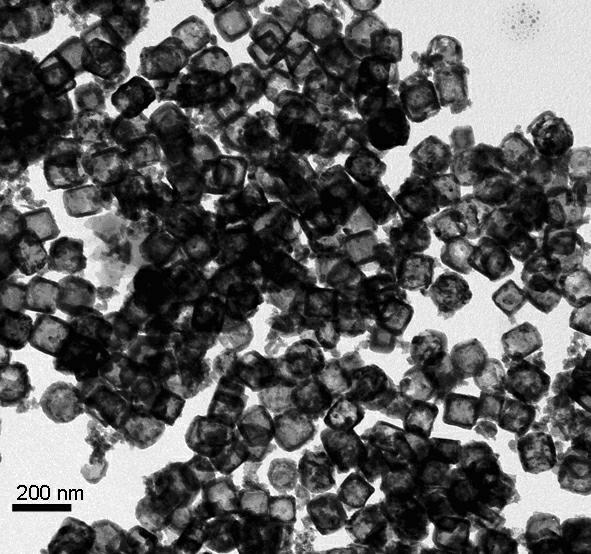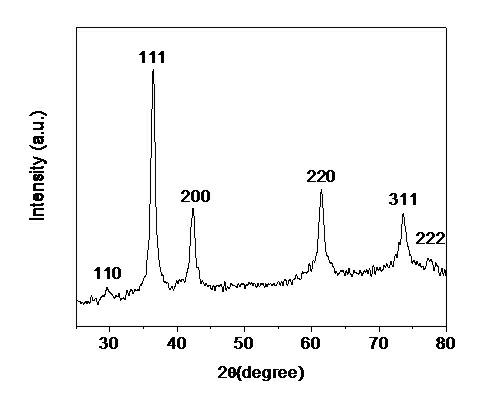Preparation method of cuprous oxide hollow nanometer cubes
A hollow nanometer, cuprous oxide technology, applied in copper oxide/copper hydroxide, nanotechnology and other directions, can solve the problems of affecting the product, inconvenient cleaning of the product, affecting the purity of the final product, etc., and achieve a simple reaction system and simple production equipment. Effect
- Summary
- Abstract
- Description
- Claims
- Application Information
AI Technical Summary
Problems solved by technology
Method used
Image
Examples
Embodiment 1
[0019] Embodiment 1: Prepare cuprous oxide hollow nanocubes according to the following steps
[0020] (1) Add copper acetylacetonate to the polyol, and raise the temperature to the reaction temperature at a certain heating rate under the stirring condition of 1000 rpm, wherein the weight ratio of the polyol to copper acetylacetonate is 1:0.0005; wherein, The polyol is ethylene glycol; wherein, the heating rate is 2°C / sec; wherein, the reaction temperature is 180°C;
[0021] (2) After reacting for 6 hours, the above solution was left to cool to room temperature, and the product was washed several times with ethanol and deionized water to obtain a light yellow precipitate, which was dried at 70°C to obtain a cuprous oxide hollow nanometer cube.
Embodiment 2
[0022] Embodiment 2: Prepare cuprous oxide hollow nanocubes according to the following steps
[0023] (1) Add copper acetylacetonate to the polyol, and raise the temperature to the reaction temperature at a certain heating rate under the stirring condition of 1100 rpm, wherein the weight ratio of the polyol to copper acetylacetonate is 1:0.001; wherein, The polyol is sorbitol; wherein, the heating rate is 3°C / sec; wherein, the reaction temperature is 200°C;
[0024] (2) After reacting for 5 hours, the above solution was left to cool to room temperature, and the product was washed several times with ethanol and deionized water to obtain a light yellow precipitate, which was dried at 70°C to obtain hollow cuprous oxide nanoparticles cube.
Embodiment 3
[0025] Embodiment 3: Prepare cuprous oxide hollow nanocubes according to the following steps
[0026] (1) Add copper acetylacetonate to the polyol, and raise the temperature to the reaction temperature at a certain heating rate under the stirring condition of 1250 rpm, wherein the weight ratio of the polyol to copper acetylacetonate is 1:0.01; wherein, Polyhydric alcohol is glycerol; Wherein, described heating rate is 4 ℃ degree / second; Wherein, described reaction temperature is 220 ℃ degree;
[0027] (2) After reacting for 3 hours, the above solution was left to cool to room temperature, and the product was washed several times with ethanol and deionized water to obtain a light yellow precipitate, which was dried at 70°C to obtain a cuprous oxide hollow nanometer cube.
PUM
 Login to View More
Login to View More Abstract
Description
Claims
Application Information
 Login to View More
Login to View More - R&D
- Intellectual Property
- Life Sciences
- Materials
- Tech Scout
- Unparalleled Data Quality
- Higher Quality Content
- 60% Fewer Hallucinations
Browse by: Latest US Patents, China's latest patents, Technical Efficacy Thesaurus, Application Domain, Technology Topic, Popular Technical Reports.
© 2025 PatSnap. All rights reserved.Legal|Privacy policy|Modern Slavery Act Transparency Statement|Sitemap|About US| Contact US: help@patsnap.com



